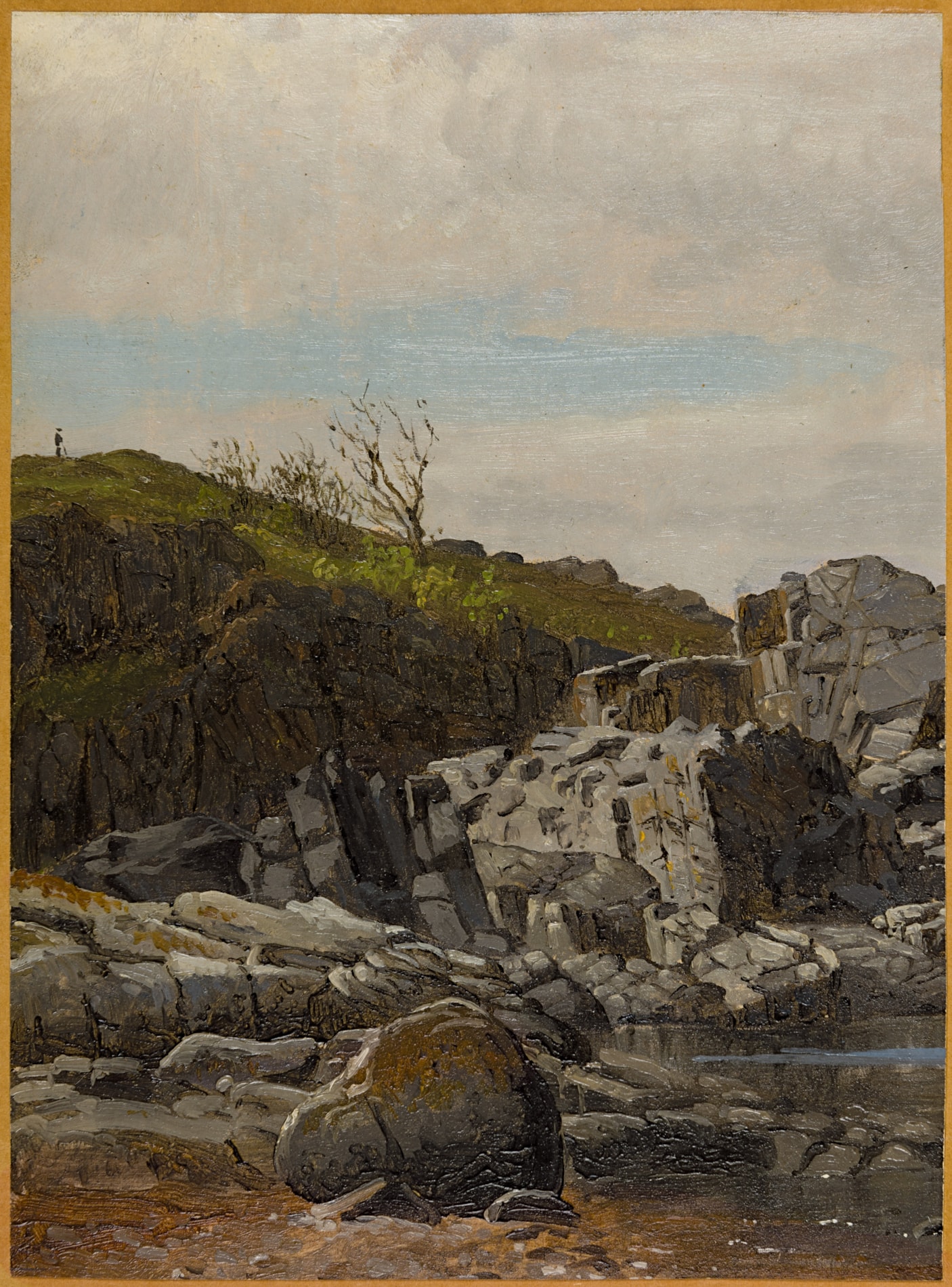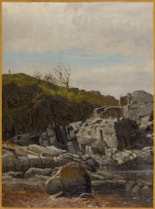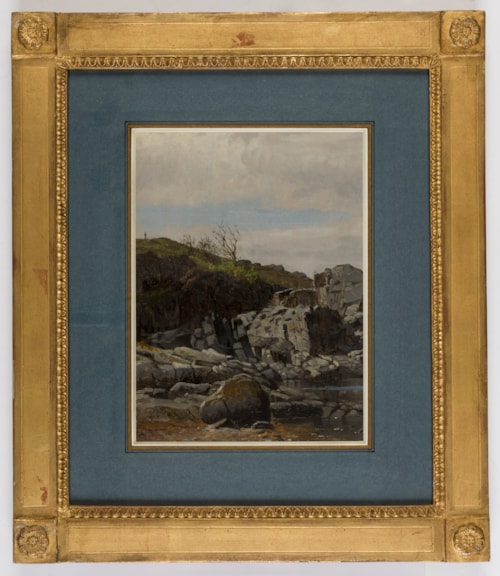Viggo FAUERHOLDT
(Copenhagen 1832 - Düsseldorf 1883)
Randkløve Skår, near Gudhjem on the East Coast of Bornholm
Sold
Oil on paper.
Inscribed and dated W. Fauerholt del 1857. on the mount.
238 x 175 mm. (9 3/8 x 6 7/8 in.)
Inscribed and dated W. Fauerholt del 1857. on the mount.
238 x 175 mm. (9 3/8 x 6 7/8 in.)
Dated 1857, this small oil sketch is a view of the coastal rock formation of Randkløve Skår on the east coast of the Baltic island of Bornholm. Located southeast of the town and fishing port of Gudhjem, which Fauerholdt painted often, Randkløve Skår is a natural cleft or ravine in the rock cliff face, shaped by the movements of ice over millions of years.
As the author of a 19th century American guidebook noted, ‘The scenery and geological nature of Bornholm differ so essentially from the other parts of Denmark – wild coasts, and picturesque rocks but a few hundred feet above sea-level…A walk should be taken to a wild spot on the coast – Randklöveskaaret, east of Österlarsker...’ The precise location of this coastal view can be determined as a little north of the small fishing village of Ypnasted. Today the coastline at Randkløve Skår is much less barren than it appears in this oil sketch, since sheep are no longer grazed on the cliffs and the landscape is now heavily overgrown with vegetation.
The present sheet is a study for the left edge of one of Viggo Fauerholdt’s best-known early paintings; a much larger and more panoramic view of Randkløve Skår and the east coast of Bornholm, also dated 1857, that is today in the collection of the Bornholms Konstmuseum. The painting, which was probably exhibited in 1858 at the Kunstakadamiet in the Charlottenborg Palace in Copenhagen, was acquired by the museum on Bornholm in 1985. Another painting of the coast of Bornholm by Fauerholdt is in the collection of the Deutsches Schifffahrtsmuseum (the German Maritime Museum) in Bremerhaven.
The mount of this oil sketch bears the drystamp of the 19th century Danish collector Benjamin Wolff (1790-1866), with whose descendants it remained for over 150 years.
As the author of a 19th century American guidebook noted, ‘The scenery and geological nature of Bornholm differ so essentially from the other parts of Denmark – wild coasts, and picturesque rocks but a few hundred feet above sea-level…A walk should be taken to a wild spot on the coast – Randklöveskaaret, east of Österlarsker...’ The precise location of this coastal view can be determined as a little north of the small fishing village of Ypnasted. Today the coastline at Randkløve Skår is much less barren than it appears in this oil sketch, since sheep are no longer grazed on the cliffs and the landscape is now heavily overgrown with vegetation.
The present sheet is a study for the left edge of one of Viggo Fauerholdt’s best-known early paintings; a much larger and more panoramic view of Randkløve Skår and the east coast of Bornholm, also dated 1857, that is today in the collection of the Bornholms Konstmuseum. The painting, which was probably exhibited in 1858 at the Kunstakadamiet in the Charlottenborg Palace in Copenhagen, was acquired by the museum on Bornholm in 1985. Another painting of the coast of Bornholm by Fauerholdt is in the collection of the Deutsches Schifffahrtsmuseum (the German Maritime Museum) in Bremerhaven.
The mount of this oil sketch bears the drystamp of the 19th century Danish collector Benjamin Wolff (1790-1866), with whose descendants it remained for over 150 years.
The son of a merchant, the marine painter Viggo Fauerholdt studied at the Royal Danish Academy of Fine Arts (the Kunstakadamiet) in Copenhagen between 1846 and 1852. He exhibited regularly at the Kunstakadamiet between 1854 and 1867, showing a total of forty-two works, and in 1857 won the Neuhausen Prize. Fauerholdt travelled widely throughout Denmark, painting in and around Copenhagen and also at Helsingør, Sønderbog, Rudkøbing, Svendborg and on the island of Fanø. Many of his exhibited works from 1856 onwards were views of the rugged coastline of the Danish island of Bornholm, situated in the Baltic Sea well to the east of the rest of Denmark, and midway between the south coast of Sweden and the northern coasts of Germany and Poland. Inspired by the contemporary Germanic tradition of picturesque landscape painting, Fauerholdt was one of the first Danish artists to paint the dramatic coastline of Bornholm, and must have lived on the island for several years. In 1862 one of his views of Bornholm was acquired by King Frederik VII of Denmark. Three years later, in 1865, Fauerholdt left Denmark and settled in Düsseldorf, where he lived and worked until his death. For the remainder of his career he painted coastal and shipping scenes and seascapes, mainly in Germany and Holland.
Provenance
Benjamin Wolff, Engelholm, Denmark (Lugt 420), with his drystamp on the mount
Thence by descent in the Wolff Sneedorf family until 2018.
Thence by descent in the Wolff Sneedorf family until 2018.





